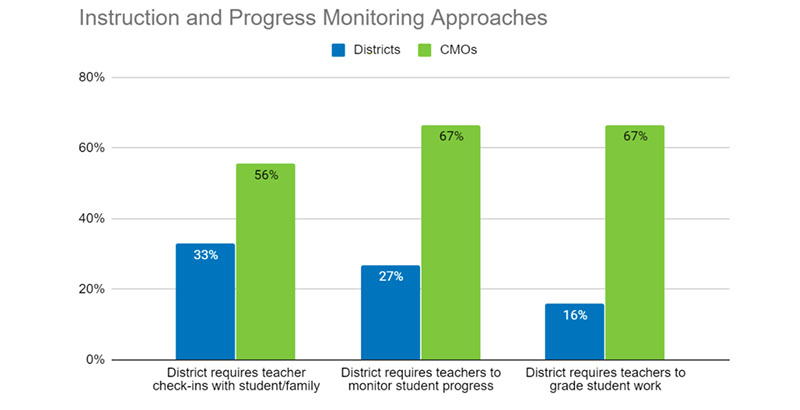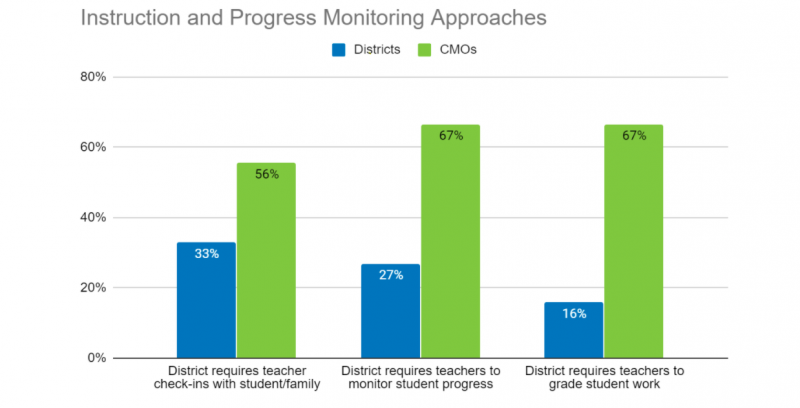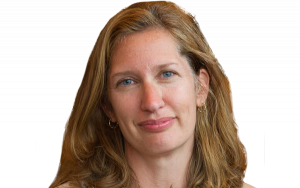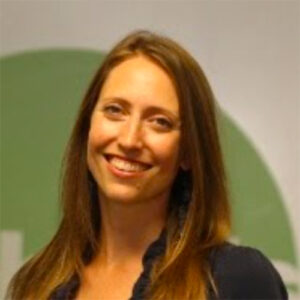Analysis: How 18 Top Charter School Networks Are Adapting to Online Education, and What Other Schools Can Learn From Them

As public schools across the country build out remote learning plans to support students during school closures prompted by the novel coronavirus, some of the nation’s most prominent charter networks have made rapid leaps from the classroom to the cloud.
Many of them are holding real-time online classes, checking in regularly with their students and grading student work.
Those practices remain somewhat rare in our examination of remote learning in 82 school districts across the country. The Center on Reinventing Public Education began tracking these efforts three weeks ago.
This week, we added 18 charter school management organizations (CMOs) to our database.
Several charter school networks we reviewed have quickly rolled out plans that include synchronous instruction — meaning they bring groups of students together virtually to receive instruction at the same time — as well as tracking students’ attendance and grading their work. Some of these organizations also rethought teachers’ job descriptions to support remote learning and are sharing resources that could help other schools develop remote learning plans.
We selected CMOs that are part of the Charter School Growth Fund portfolio and serve 10 or more schools. We were curious to see if we could find common trends or variation in their approaches. Here is an early snapshot:
The CMOs prioritize progress monitoring and continuous improvement and are moving toward synchronous learning.
The CMOs and districts we reviewed were not chosen at random, and their numbers are too small to enable broad comparisons between district and charter systems. Like districts, CMOs vary in their approaches. Two of the 18 we reviewed provided no access to educational resources. But half (nine of 18) have created comprehensive learning plans with formal curriculum, instruction and progress monitoring.
Compared with the districts we have examined, the charter school networks were far more likely to monitor student progress. They did this by holding frequent one-on-one check-ins between students and adults, assigning and grading student work, and using digital platforms that enable real-time monitoring and attendance tracking, such as Google Classrooms, Microsoft Teams and Canvas. One creative riff on taking attendance is KIPP New Jersey’s required question of the day that students must complete by noon.

Some CMOs require teachers to serve as advisers who build relationships with groups of students and help them troubleshoot academic and behavior issues, apply for college or connect with resources.
Several charter school networks we reviewed use these advisers to support relationship building and progress monitoring. At DSST Public Schools in Denver and Aurora, Colorado, advisers met with students virtually to test connectivity and explain the schools’ remote learning program before its April 8 launch. DSST planned for students to use Microsoft Teams for meetings with its existing advisory cohorts and for four daily learning blocks taught by current teachers Monday through Thursday. Assignments will be due by Friday at 8 a.m., with most of that day set aside for self-directed student time, independent work and individualized support in virtual office hours. DSST has set a goal for 100 percent of students to have a weekly one-on-one appointment with their advisers.
Nine of the CMOs we reviewed provide online instruction. Uncommon Schools, which operates in the Northeast, has created online learning channels for each grade level, filled with pre-recorded lessons from their top teachers. This content is publicly available for any interested student — or, potentially, other schools.
Achievement First, also in the Northeast, provides differentiated, teacher-led learning in all middle and high school classes through Zoom videoconferencing and kicks off each day with an advisory period with teachers and small groups of students. Elementary students don’t receive synchronous learning, instead spending structured time blocks on online or paper activities.
Even many networks that do not require synchronous learning or virtual instruction prioritize teacher monitoring and check-ins as an important touch point for students. Out of concern for device access and at-home responsibilities for students and families, RePublic Schools, which operates in Tennessee and Mississippi, provides daily assignments for students but no synchronous learning. Yet all teachers offer office hours, and they are expected to call students weekly to check in.
Of the 18 CMOs we reviewed, 14 reported some plan for distributing devices to students. Meeting this first-order need for technology allows CMOs to expect more from students and families in their remote learning plans.
CMOs are flexing teacher roles to serve students remotely.
Our review of guidance posted on their websites, as well as open-access online learning materials, shows that some CMOs are shifting school practices to adapt to the realities of online learning. First, school days have structure but afford teachers more flexibility than typical bell schedules allow. Second, teachers are dividing and conquering tasks. Third, collaboration extends across school sites for grade-level or content teams.
At Rocketship Public Schools, which operates in California, Tennessee, Wisconsin and Washington, D.C., educators share recorded Zoom lessons with colleagues across the network. Teachers at the tech-savvy charter network were already used to recording themselves to practice lessons or allow students to access them later, so it made sense to use the videos for remote professional development. Teacher leaders record example lessons and share them with others in the same grade and subject; leaders can use these videos to highlight effective practices.
For each grade level and subject area at New York City’s Success Academy, one teacher leads synchronous class time while others review students’ work as class proceeds, grade assignments and make daily check-in calls to students. This way, teachers can maintain strong touch points with their students while providing quality instruction.
Some Achievement First schools have one teacher lead synchronous lessons for a whole grade, while others prepare, check in with students or grade assignments. These offline tasks are more flexible for teachers with other at-home responsibilities to manage.
Achievement First sought to create the best possible experiences for students while honoring the challenges teachers face at home. While students benefit from routines, teachers are often parents as well, juggling multiple obligations. The network outlines responsibilities and suggested daily schedules, but its guide to staff expectations for remote learning stresses flexibility and collaboration among school and grade-level teams to design their own strategies.
How might CMOs drive better remote learning in all public schools?
Charter schools arguably have more flexibility than districts to try different strategies and incubate new ideas. Yet our initial review found that as CMOs and districts build their at-home learning plans, instruction tends to replicate traditional classroom structures. Synchronous learning efforts aim to replicate a typical classroom experience, virtually — teacher-directed lessons, interspersed with student discussion and independent work.
This makes sense, because all schools’ first priority should be to quickly give students access to remote learning. But charter schools’ flexibility could offer opportunities for innovation later, as schools come to grips with the long-term effects a pandemic could have on their normal operations. What could teachers and students do differently with their time and learning strategies, given this new learning environment? How can they strengthen student-to-student learning and student-led collaboration, especially for older grades?
DSST is just starting to play with this idea with its altered weekly schedule. Some districts, including San Antonio Independent School District, have noted that state testing waivers could provide an opportunity for teachers to employ more creativity.
The fast efforts of some leading CMOs have produced a wealth of publicly available resources — from Uncommon Schools’ videos to Achievement First’s guide to staff expectations to Rocketship’s reflections on the rollout of remote learning — that can inform efforts in other schools.
Once schools settle into remote learning, this time presents opportunities for leading charter school networks to pilot and track innovations: allowing students to explore specific interests more deeply, nurturing new self-directed learning habits and trying out mold-breaking “classroom” structures. This unprecedented disruption to learning will require unprecedented solutions.
We believe that “horse race” comparisons that pit charter schools against school districts are especially odious in a time of national crisis and add little value to efforts to ensure that learning continues for as many children as possible. It’s time to pause the usual education reform debates and focus on the monumental challenge all public schools face.
No one knows what the right path is. This is a time for everyone in public education to learn from one another, and we at CRPE are trying to create transparency in different approaches to help that happen. We hope more charter school organizations will take advantage of their flexibility to help us find them, and continue sharing what they learn so all schools can benefit.
Robin Lake is director of the Center on Reinventing Public Education at the University of Washington Bothell. You can find her on Twitter @RbnLake. Bree Dusseault is practitioner-in-residence at the Center on Reinventing Public Education, supporting its analysis of district and charter responses to COVID-19. She previously served as executive director of Green Dot Public Schools Washington, executive director of pK-12 schools for Seattle Public Schools, a researcher at CRPE, and as a principal and teacher.
Get stories like these delivered straight to your inbox. Sign up for The 74 Newsletter

;)

